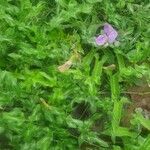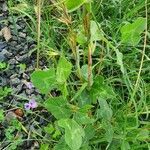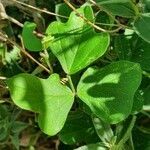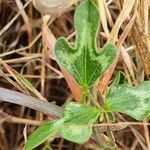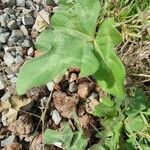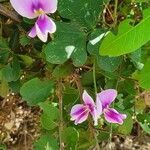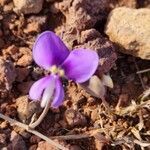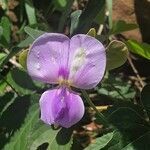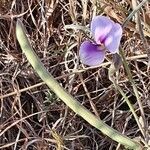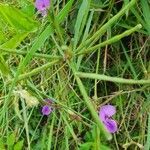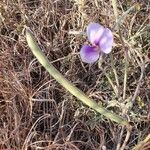Perennial prostrate or climbing herb, 0·5–1·5 m. long, or erect at first and only 7–20 cm. tall when appearing after burns, sometimes flowering before the leaves appear; rootstock a woody tuber often 5 cm. wide.. Stems densely ferruginous pubescent, usually velvety, less often glabrous.. Leaflets 3, ovate, oblong-ovate or rhomboid (rarely hastate) in outline, 1·5–7·5(–9·5) cm. long, 1–4·7 cm. wide, entire to deeply 3-lobed, acute to slightly emarginate and mucronulate at the apex, broadly cuneate or rounded at the base, sparsely to densely velvety pubescent with rather short adpressed tubercular-based hairs or rarely glabrescent; petiole 1–5·5 cm. long; rhachis 2–10 mm. long; petiolules 1 mm. long; stipules oblong-lanceolate to lanceolate, 4·5–8 mm. long, slightly prolonged and cordate at the base.. Inflorescences axillary or terminal, subumbellate, several-flowered; peduncle 1·2–19 cm. long; pedicels 2–4 mm. long; bracteoles subpersistent, ovate-oblong, 1·5–2 mm. long.. Flowers scented.. Calyx practically glabrous to velvety pubescent; tube 3·5–5 mm. long; lobes triangular, 2–10 mm. long, the upper pair united for ± half their length.. Standard mauve-lilac or whitish, often greyish outside, usually with a yellow basal area inside surrounded by a darker deep purple zone, oblate, 1·5–2·6 cm. long, 1·5–2·8 cm. wide, emarginate, glabrous or velvety outside; wings pale mauve-lilac with very pale tips; keel very pale lilac, the beak short, slightly incurved.. Stigma produced as a subulate beak some 2 mm. beyond the stigma.. Pods held erect, linear-cylindrical, 6–11 cm. long, 4–5 mm. wide, ± pubescent with short adpressed hairs or almost glabrous, 12–16-seeded.. Seeds red-brown with dense black speckling, oblong-ellipsoid, longest dimension 3–5 mm., shorter dimension 2·5–3 mm., 2–2·8 mm. thick; hilum ± central, small; aril not developed.
More
Perennial, pyrophytic climber, 0.1-1.0 m high/long; rootstock a woody tuber, plants ferruginous with velvety hairs, rarely glabrous. Leaflet trilobal to widely hastate, ± 60 x 48 mm, apex and base obtuse, venation trinerved from base, then reticulate; petioles 9-48 mm long. Stipules oblong-lanceolate, 4.5-8.0 mm long. Inflorescences of contracted racemes with several large flowers. Flowers precocious after grass fires. Calyx: lobes ± as long as tube. Petals: standard large, oblate, up to 30 mm in diam., repand; keel gently incurved, obtuse. Style with spathe-like beak, up to 2 mm long. Pod erect, 60-90 mm long, shortly beaked, brown, shortly appressed-hairy. Seeds 12-16.
A climbing herb. It grows 1.5 m long. It has a root tuber 5 cm across. The leaves have 3 leaflets. There are several flowers in a group. The flowers have a scent. The pods are erect and 6-11 cm long by 5-4 mm wide. The seeds are red-brown with red speckles.
Woodland with Combretum collinum, C. molle, Annona senegalensis; or with Combretum molle, Stereospermum kunthianum, Erythrina abyssinica, Entada abyssinica; Loudetia arundinacea grassland on shallow soil, mostly subject to seasonal burning; etc.
